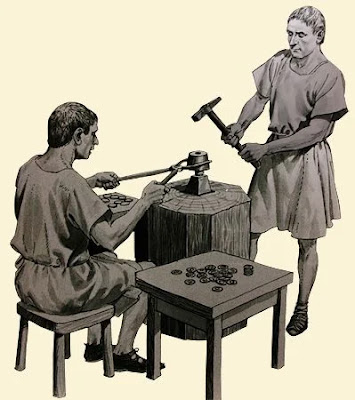Striking of coins in a coining press can be subject to various errors that result in imperfect strikes. These errors can include off-center strikes, multiple strikes, rotated dies, misaligned dies, weak strikes, overstrikes, and more. Each type of error can impact the appearance and quality of the coin, leading to inconsistencies in design and potentially affecting its value.
Now let us look at some coin errors which pertain to coin Striking.
Broad Strike
Coin struck without a collar, thus when the coin is struck the metal is allowed to expand and increase in diameter. May be centered or un-centered, but must not have any missing lettering or design detail.
Capped Die Strike
When a die cap error is occurring, the dies continue to strike more coins even though a coin is capped around one of the dies. If the coin is capped around the obverse die, the coins stuck with that die will appear blank or have varying degrees of mushiness on the obverse due to the obverse die being obstructed. If the cap stays on indefinitely, eventually it will wear through the planchet and the coins struck by that die will become less and less obstructed causing a "late-stage" capped die strike where the image is less distorted.
Die Axis Rotation
While minting a coin, both the dies are kept in such a position, that the top most design of the obverse and reverse coin exactly face each other. This type of error occurs, when one of the dies is rotated with respect to the other die. In this type of error, the Obverse / Reverse Die is rotated, anywhere from 5-180 degrees clockwise or counterclockwise.
Double Denomination
Occurs when an already struck coin is struck by a pair of dies of a different denomination. These coins will show details of both denominations. Usually, the details of the denomination of the last dies to strike to coin are strongest and some double denomination coins barely show any detail from the denomination of the first strike.
Double Strike
If a coin fails to be properly ejected from the striking chamber after being stuck and the dies come down again to strike the coin again, a double strike occurs. Double strikes can occur with the second strike off center or on-center. In the same way triple and multiple struck coins occur.
Machine Doubling
This type of doubling occurs when the die strikes a planchet. If the die is not properly seated, it can move slightly or bounce during the moment of striking, creating a flat, shelf-like doubling. This effect will be different on all coins struck, so it is technically not a variety, but rather more of a striking error.
Off Center
Coin struck without a collar and off center, different from the un-centered broad strike because part of the lettering or design detail is missing.
Struck through Error
Occurs when a foreign object lies on top of the planchet and leaves an impression of itself when struck into the coin. A wide variety of objects have been reported including grease, string, cloth, hair, plastic, band-aid, staples, etc.
Occurs when a foreign object lies on top of the planchet and leaves an impression of itself when struck into the coin. A wide variety of objects have been reported including grease, string, cloth, hair, plastic, band-aid, staples, etc.
Weak strike
Occurs when there is insufficient pressure from the dies to leave a full impression on the planchet. This can occur for a variety of reasons but usually occurs when the power to the presses is turned off and the dies continue to strike coins with less and less pressure until coming to a stop. If the coin is simply struck through grease, some details may be strong and the edge reading will also be strong.











I have a few error coins , one but i havent seen the type of errors before , one coin only has one weak letter and one has a restrike error but only i certain areas
ReplyDelete